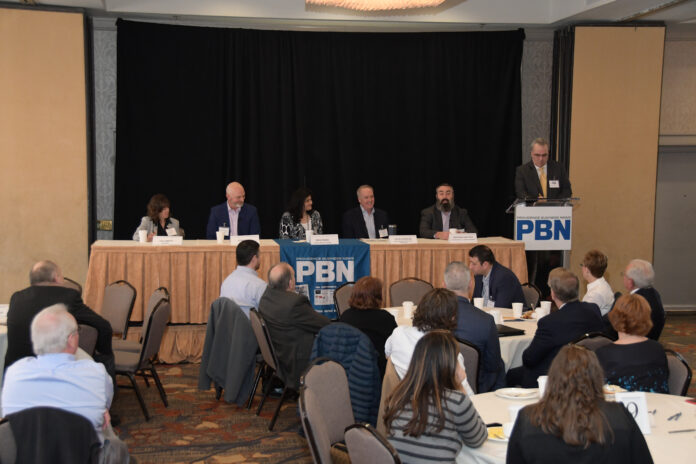
PROVIDENCE — With employers in nearly every industry reporting recruitment and retention as among their largest challenges – if not the largest – employers need to stay on top of workforce and employee priorities, according to industry leaders.
“It’s an employees’ market, and we all know it,” said Lisa Abbott, senior vice president of human relations and community affairs at Lifespan Corp. “Anyone who’s hiring knows it.”
At a Workforce Development summit hosted by Providence Business News Tuesday morning at Providence Marriott Downtown, Abbott and fellow industry leaders advised businesses on how to keep up or catch up with a competitive workforce’s shifting priorities.
In today’s market, employers who hold rigidly to pre-pandemic work expectations are the ones struggling, said Nina Pande, executive director of Skills for Rhode Island’s Future.
“If employers were quick to pivot and recognize what employees want, they’re successful,” Pande said.
But for businesses who continue to struggle, there are still multiple opportunities to adapt to the demands of today’s workforce, the industry leaders said.
The business leaders also agreed that employees aren’t just looking for traditional perks – while offerings such as competitive wages remain important – they’re not the only tools businesses have to work with, panelists said. And as people retire early at increasing rates, employers need to recognize the different needs of the younger workforce.
If businesses don’t have the financial ability to raise wages, they can consider measures such as allowing work from home, flexible scheduling and promoting growth opportunities within the company, said Matthew Weldon, director of the R.I. Department of Labor and Training.
“People are living differently, and they want to continue that work-life balance,” Weldon said.
Employees “can do both and be good at both,” Weldon added on balancing personal and professional priorities.
While work from home and flexible scheduling have come under the spotlight for the past two years, employers can also think beyond these now expected perks. As an example, Weldon said, businesses may consider allowing employees to divide their hours between four work days, rather than five.
And when perks such as work from home aren’t possible in all industries, employers need to think creatively, industry leaders said.
Work from home opportunities in health care were once thought of as completely unrealistic, Abbott said, but when the pandemic struck, “we did it in 10 minutes when we had to,” she noted, with telehealth shifting from a rarity to a normal aspect of health care for many patients.
With a smaller pool of students graduating from college, and with students at all levels having missed out on socialization and in-person training opportunities over the past two years, businesses also need to increase their training program offerings and anticipate increased mental health needs among employees, industry leaders suggested.
“The students we’re seeing come to us are less prepared than we’ve seen in the past,” said Doug Sherman, senior vice president and provost of New England Institute of Technology.
Some businesses can also find opportunity for themselves and potential employees’ in the decline of college enrollment rates, with this trend highlighting alternative career paths that can be accessed through trade school or a regular high school diploma.
This shift has made a difference in the construction industry, said Steve Duvel, New England division leader of Gilbane Building Company.
“From a career standpoint, we’re in a great place,” Duvel said. “You can graduate high school and state a career in construction and make as much as a four-year degree individual coming right out of college, without debt.”
While businesses can take important steps, they shouldn’t be asked to face workforce challenges alone, Pande said, encouraging employers to take advantage of programs such as Real Jobs Rhode Island.
“Make sure your voices are known, make sure people understand your needs,” she said.












